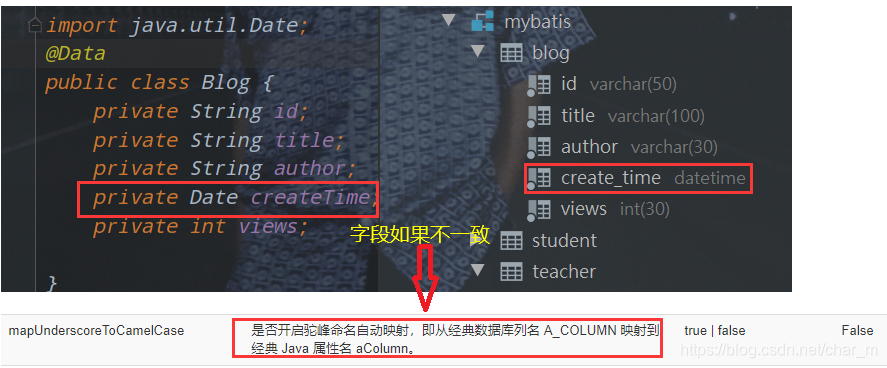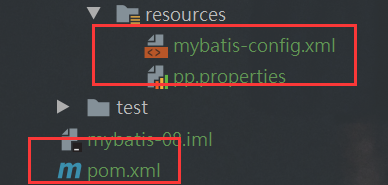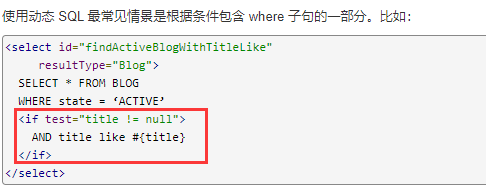动态SQL就是根据不同的条件生成不同的SQL语句
动态SQL就是在拼接SQL语句,我们只要保证SQL的正确性,按照SQL的格式,去排列组合就可以了
动态 SQL 元素可能会感觉似曾相识。在 MyBatis 之前的版本中,需要花时间了解大量的元素。借助功能强大的基于 OGNL 的表达式,MyBatis 3 替换了之前的大部分元素,大大精简了元素种类,现在要学习的元素种类比原来的一半还要少。
if
choose (when, otherwise)
trim (where, set)
foreach
搭建环境
数据库
CREATE TABLE `blog`(
`id` VARCHAR(50) NOT NULL COMMENT '博客id',
`title` VARCHAR(100) NOT NULL COMMENT '博客标题',
`author` VARCHAR(30) NOT NULL COMMENT '博客作者',
`create_time` DATETIME NOT NULL COMMENT '创建时间',
`views` INT(30) NOT NULL COMMENT '浏览量'
)ENGINE=INNODB DEFAULT CHARSET=utf8


在核心配置文件中设置

导包和之前的项目一样
配置文件
<?xml version="1.0" encoding="UTF-8" ?>
<!DOCTYPE configuration
PUBLIC "-//mybatis.org//DTD Config 3.0//EN"
"http://mybatis.org/dtd/mybatis-3-config.dtd">
<!--核心配置文件-->
<configuration>
<!-- 引入外部配置文件-->
<properties resource="pp.properties"/>
<settings>
<!-- 标准的日志工厂-->
<setting name="logImpl" value="STDOUT_LOGGING"/>
<!-- <setting name="logImpl" value="LOG4J"/>-->
</settings>
<!--给实体类起别名-->
<typeAliases>
<package name="com.my.pojo"/>
</typeAliases>
<environments default="development">
<environment id="development">
<transactionManager type="JDBC"/><!--事务管理-->
<dataSource type="POOLED">
<property name="driver" value="${driver}"/>
<property name="url" value="${url}"/>
<property name="username" value="${username}"/>
<property name="password" value="${password}"/>
</dataSource>
</environment>
</environments>
<mappers>
<mapper class="com.my.dao.BlogMapper"/>
</mappers>
</configuration>
driver=com.mysql.jdbc.Driver
url=jdbc:mysql://localhost:3306/mybatis?useSSL=true&userUnicode=true&characterEncoding=UTF-8
username=root
password=123456

实体类
import lombok.Data;
import java.util.Date;
@Data
public class Blog {
private String id;
private String title;
private String author;
private Date createTime;
private int views;
}
连接类

package com.my.utils;
import org.apache.ibatis.io.Resources;
import org.apache.ibatis.session.SqlSession;
import org.apache.ibatis.session.SqlSessionFactory;
import org.apache.ibatis.session.SqlSessionFactoryBuilder;
import java.io.IOException;
import java.io.InputStream;
//sqlSessionFactory 构建sqlSession
public class MybatisUtils {
private static SqlSessionFactory sqlSessionFactory;
static {
try{
//使用mybatis第一步 获取sqlSessionFactory对象
String resource = "mybatis-config.xml";
InputStream inputStream = Resources.getResourceAsStream(resource);
sqlSessionFactory = new SqlSessionFactoryBuilder().build(inputStream);
} catch (IOException e) {
e.printStackTrace();
}
}
public static SqlSession getSqlSession(){
return sqlSessionFactory.openSession(true);
}
}
接口和xml
package com.my.dao;
public interface BlogMapper {
}
<?xml version="1.0" encoding="UTF-8" ?>
<!DOCTYPE mapper
PUBLIC "-//mybatis.org//DTD Config 3.0//EN"
"http://mybatis.org/dtd/mybatis-3-mapper.dtd">
<!--核心配置文件-->
<mapper namespace="com.my.dao.BlogMapper" >
</mapper>
插入数据

测试代码
import com.my.dao.BlogMapper;
import com.my.pojo.Blog;
import com.my.utils.IDUtils;
import com.my.utils.MybatisUtils;
import org.apache.ibatis.session.SqlSession;
import org.junit.Test;
import java.util.Date;
public class MyTest {
@Test
public void addBlogTest(){
SqlSession sqlSession = MybatisUtils.getSqlSession();
BlogMapper mapper = sqlSession.getMapper(BlogMapper.class);
Blog blog = new Blog();
blog.setId(IDUtils.getId());
blog.setTitle("Mybatis");
blog.setAuthor("狂神");
blog.setCreateTime(new Date());
blog.setViews(9999);
mapper.addBook(blog);
blog.setId(IDUtils.getId());
blog.setTitle("Java");
mapper.addBook(blog);
blog.setId(IDUtils.getId());
blog.setTitle("Spring");
mapper.addBook(blog);
blog.setId(IDUtils.getId());
blog.setTitle("微服务");
mapper.addBook(blog);
// 因为在前面的连接中设置自动提交事务所以这里不用commit
sqlSession.close();
}
}

动态SQL之if


使用where标签
如果两个条件都成立,where标签会自动将第一个语句的起始and去掉,如果都不成立,会自动将where去掉

<select id="queryBlogIf" parameterType="map" resultType="blog">
select * from mybatis.blog
<where>
<if test="title != null">
and title = #{
title}
</if>
<if test="author != null">
and author = #{
author}
</if>
</where>
</select>


条件成立进入if标签


动态SQL之choose (when, otherwise)

<select id="queryBlogChoose" parameterType="map" resultType="blog">
select * from mybatis.blog
<where>
<choose>
<when test="title != null">
title = #{
title}
</when>
<when test="author != null">
and author = #{
author}
</when>
<otherwise>
and views = #{
views}
</otherwise>
</choose>
</where>
</select>




set标签

只要满足if的条件就可以拼接在sql中,最后一个修改的内容后不加逗号



trim标签


SQL片段
可以使用sql标签解决代码复用问题
- 使用sql标签抽取公共的部分
- 在需要使用的地方使用include标签引用即可
最好基于单表来定义SQL
不要存在where标签,因为where涉及一些条件的判断

foreach


<!--select * from mybatis.blog where in(id=1 or id = 2 or id=3)
传递一个万能的map,这个map中可以存在一个集合
-->
<select id="queryBlogForeach" parameterType="map" resultType="blog">
select * from mybatis.blog
<where>
<foreach collection="ids" item="id" open="and (" close=")" separator="or">
id = #{
id}
</foreach>
</where>
</select>
@Test
public void queryBlogForeach(){
SqlSession sqlSession = MybatisUtils.getSqlSession();
BlogMapper mapper = sqlSession.getMapper(BlogMapper.class);
HashMap map = new HashMap();
List<Integer> ids = new ArrayList<Integer>();
map.put("ids",ids);
ids.add(1);
ids.add(2);
ids.add(4);
List<Blog> blogList = mapper.queryBlogForeach(map);
for (Blog blog : blogList) {
System.out.println(blog);
}
sqlSession.close();
}

